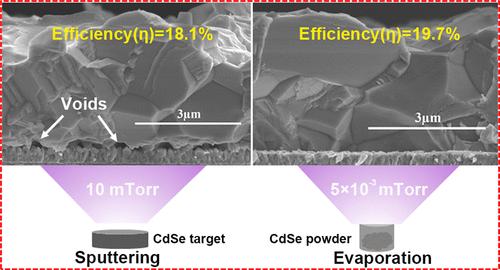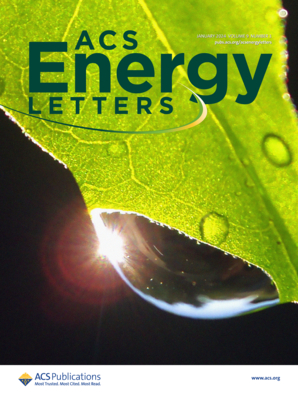Evaporated CdSe for Efficient Polycrystalline CdSeTe Thin-Film Solar Cells
IF 18.2
1区 材料科学
Q1 CHEMISTRY, PHYSICAL
引用次数: 0
Abstract
Recent progress has shown that alloying cadmium telluride (CdTe) with cadmium selenide (CdSe) to create a CdSexTe1–x (CdSeTe) gradient region can significantly boost the performance of polycrystalline CdSeTe thin-film solar cells. However, improper CdSeTe alloying might introduce problematic band alignment and deleterious voids at the front interface, limiting the benefit maximization of this technique. Here, we show that the CdSe layers deposited by thermal evaporation result in CdSeTe cells with a higher performance than the sputtered CdSe. This is because evaporated CdSe can avoid the formation of voids at the front interface, producing improved front junction quality with suppressed front junction nonradiative recombination. The champion cell using evaporated CdSe demonstrated a power conversion efficiency (PCE) of 19.7%, much higher than 18.1% in the cell using sputtered CdSe.

蒸发CdSe用于高效多晶CdSeTe薄膜太阳能电池
最近的研究表明,将碲化镉(CdTe)与硒化镉(CdSe)合金形成CdSexTe1-x (CdSeTe)梯度区可以显著提高多晶CdSeTe薄膜太阳能电池的性能。然而,不适当的CdSeTe合金化可能会在前界面引入有问题的带对准和有害的空洞,从而限制了该技术的效益最大化。在这里,我们证明了热蒸发沉积的CdSe层导致CdSeTe电池具有比溅射CdSe更高的性能。这是因为蒸发的CdSe可以避免在前界面形成空洞,通过抑制前结非辐射复合来提高前结质量。蒸发镉镉电池的功率转换效率(PCE)为19.7%,远高于溅射镉镉电池的18.1%。
本文章由计算机程序翻译,如有差异,请以英文原文为准。
求助全文
约1分钟内获得全文
求助全文
来源期刊

ACS Energy Letters
Energy-Renewable Energy, Sustainability and the Environment
CiteScore
31.20
自引率
5.00%
发文量
469
审稿时长
1 months
期刊介绍:
ACS Energy Letters is a monthly journal that publishes papers reporting new scientific advances in energy research. The journal focuses on topics that are of interest to scientists working in the fundamental and applied sciences. Rapid publication is a central criterion for acceptance, and the journal is known for its quick publication times, with an average of 4-6 weeks from submission to web publication in As Soon As Publishable format.
ACS Energy Letters is ranked as the number one journal in the Web of Science Electrochemistry category. It also ranks within the top 10 journals for Physical Chemistry, Energy & Fuels, and Nanoscience & Nanotechnology.
The journal offers several types of articles, including Letters, Energy Express, Perspectives, Reviews, Editorials, Viewpoints and Energy Focus. Additionally, authors have the option to submit videos that summarize or support the information presented in a Perspective or Review article, which can be highlighted on the journal's website. ACS Energy Letters is abstracted and indexed in Chemical Abstracts Service/SciFinder, EBSCO-summon, PubMed, Web of Science, Scopus and Portico.
 求助内容:
求助内容: 应助结果提醒方式:
应助结果提醒方式:


